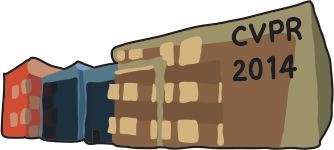-
Human Action Recognition by Representing 3D Skeletons as Points in a Lie Group
AbstractRecently introduced cost-effective depth sensors coupled with the real-time skeleton estimation algorithm of Shotton et al. [16] have generated a renewed interest in skeleton-based human action recognition. Most of the existing skeleton-based approaches use either the joint locations or the joint angles to represent a human skeleton. In this paper, we propose a new skeletal representation that explicitly models the 3D geometric relationships between various body parts using rotations and translations in 3D space. Since 3D rigid body motions are members of the special Euclidean group SE(3), the proposed skeletal representation lies in the Lie group SE(3)×. . .×SE(3), which is a curved manifold. Using the proposed representation, human actions can be modeled as curves in this Lie group. Since classification of curves in this Lie group is not an easy task, we map the action curves from the Lie group to its Lie algebra, which is a vector space. We then perform classification using a combination of dynamic time warping, Fourier temporal pyramid representation and linear SVM. Experimental results on three action datasets show that the proposed representation performs better than many existing skeletal representations. The proposed approach also outperforms various state-of-the-art skeleton-based human action recognition approaches.
Related Material
[pdf][bibtex]@InProceedings{Vemulapalli_2014_CVPR,
author = {Vemulapalli, Raviteja and Arrate, Felipe and Chellappa, Rama},
title = {Human Action Recognition by Representing 3D Skeletons as Points in a Lie Group},
booktitle = {Proceedings of the IEEE Conference on Computer Vision and Pattern Recognition (CVPR)},
month = {June},
year = {2014}
}
These CVPR 2014 papers are the Open Access versions, provided by the Computer Vision Foundation.
Except for the watermark, they are identical to the accepted versions; the final published version of the proceedings is available on IEEE Xplore.
Except for the watermark, they are identical to the accepted versions; the final published version of the proceedings is available on IEEE Xplore.
This material is presented to ensure timely dissemination of scholarly and technical work.
Copyright and all rights therein are retained by authors or by other copyright holders.
All persons copying this information are expected to adhere to the terms and constraints invoked by each author's copyright.

